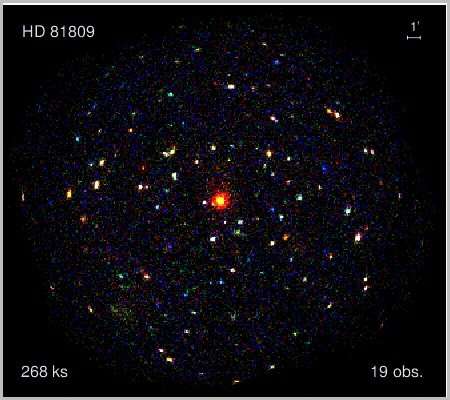First catalogue of X-ray sources in overlapping observations published

Members of the X-ray astronomy working group at the Leibniz Institute for Astrophysics (AIP) and an international team have published the first catalogue of X-ray sources in multiply observed sky regions. The catalogue comprises almost 72,000 objects, partly of exotic nature, which were observed with the space-based X-ray telescope XMM-Newton. It provides information on the physical properties of the sources and enables astronomers to identify brightness variations on time scales of several years - and includes several thousand new detections.
Since its launch end of 1999, the European X-ray satellite XMM-Newton has observed many patches of the sky repeatedly. Members of the X-ray astronomy group have developed new software to search for astrophysical objects in overlapping observations and used it to compile the first catalogue. By combining multiple observations of the same region of sky, higher accuracy is reached and faint sources are found that are not detectable in the individual observations. "Our method is similar to combining several transparencies showing the same subject: The more images are superimposed the more details become visible," explains Dr. Iris Traulsen, the project scientist at the AIP.
The new catalogue comprises 71,951 X-ray sources in 1,789 XMM-Newton observations and lists a wealth of information on their physical properties. Several thousand of these sources are newly discovered, many of them very faint and difficult to detect. The catalogue can be used to trace brightness changes of X-ray sources over time scales of up to 14.5 years. Dr. Axel Schwope, team leader at the AIP, says: "Variations of the X-ray brightness are a essential criteria used to search for exotic Celestial objects. To decipher their nature, we also employ the Large Binocular Telescope (LBT) in Arizona." The AIP is one of the LBT partners and contributes to its instrumentation and software.
Scientists all over the world have been using the XMM-Newton Source Catalogues to get new information about their research objects and to search for rare and as yet unknown sources of X-rays.
X-ray observations open a window to regions of the Universe that are invisible to human eyes. Celestial X-rays arise from extremely energetic processes, for example in hot gas at temperatures of hundreds of millions degrees. This relatively new technique has been used for some fifty years to study these often exotic objects. A single observation by ESA's space-based X-ray telescope XMM-Newton covers the same sky area as the full moon and contains fifty to one hundred X-ray sources. They range from hot or very compact, collapsed stars to massive black holes in distant galaxies and to galaxy clusters billions of light years away from the Earth.
The XMM-Newton Survey Science Centre Consortium has been established more than twenty years ago as a team of scientists in several European countries, including France, Spain, the United Kingdom and Germany. They process the publicly available XMM-Newton observations and publish catalogues of all serendipitously detected X-ray sources. The AIP contributes and maintains the source-detection software.
More information: Catalogue: xmmssc.irap.omp.eu/Catalogue/3 … s/3XMM_DR7stack.html
The XMM-Newton serendipitous survey. VIII: The first XMM-Newton serendipitous source catalogue from overlapping observations. arxiv.org/abs/1807.09178
Provided by Leibniz-Institut für Astrophysik Potsdam




















